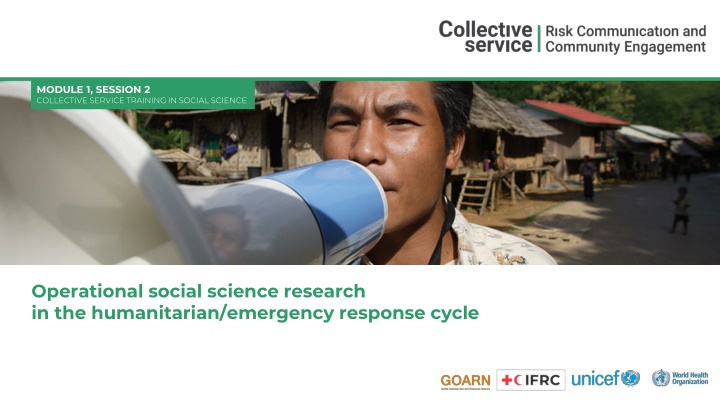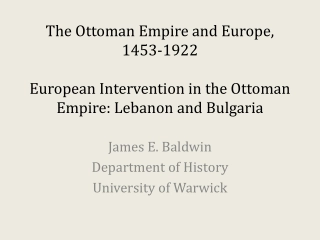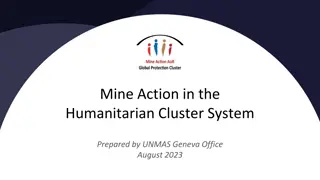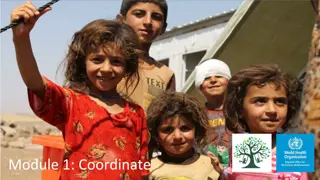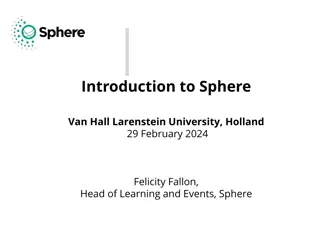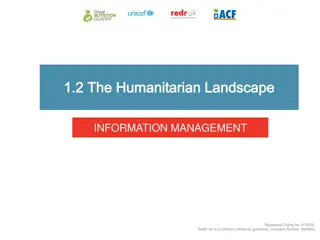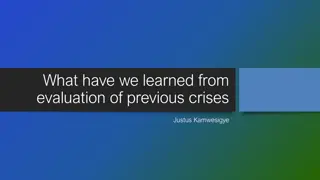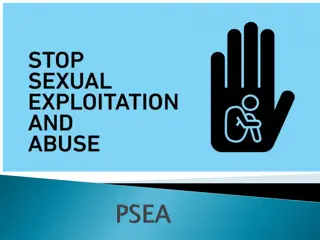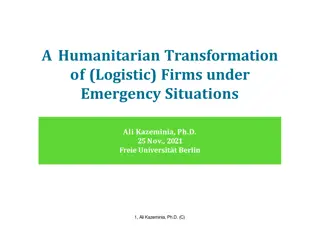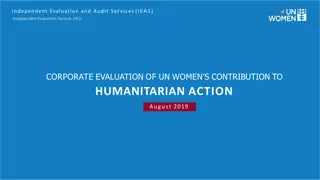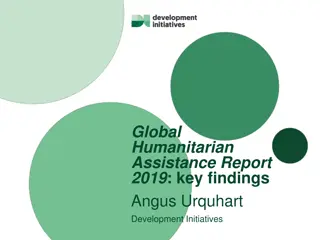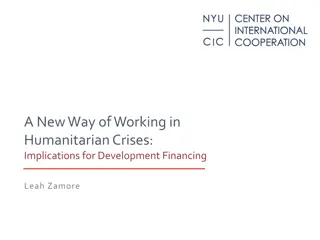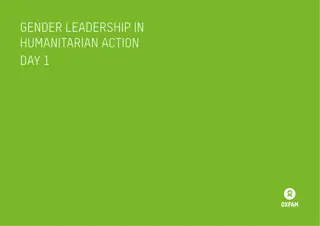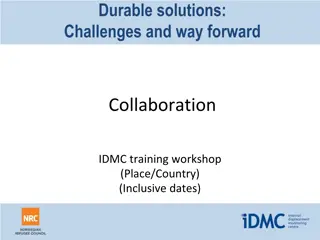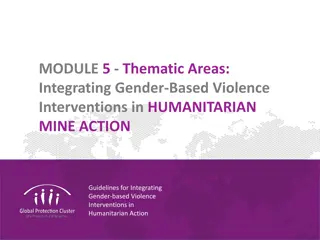Operational Social Science Research in Humanitarian Response Settings
Explore the importance and application of operational social science research in humanitarian and emergency response situations. Gain insights into engaging affected communities, generating actionable data, and promoting ethical research practices for impactful outcomes.
Download Presentation

Please find below an Image/Link to download the presentation.
The content on the website is provided AS IS for your information and personal use only. It may not be sold, licensed, or shared on other websites without obtaining consent from the author.If you encounter any issues during the download, it is possible that the publisher has removed the file from their server.
You are allowed to download the files provided on this website for personal or commercial use, subject to the condition that they are used lawfully. All files are the property of their respective owners.
The content on the website is provided AS IS for your information and personal use only. It may not be sold, licensed, or shared on other websites without obtaining consent from the author.
E N D
Presentation Transcript
MODULE 1, SESSION 2 COLLECTIVE SERVICE TRAINING IN SOCIAL SCIENCE Operational social science research in the humanitarian/emergency response cycle
LEARNING OUTCOMES Become familiar with the definition of operational social science and why it is important in time-sensitive settings Understand where the generation of quality operational social science research fits into the humanitarian/emergency programming cycle
SOCIAL SCIENCE FOR ENGAGING AFFECTED COMMUNITIES Individuals and communities capacity to respond to the crisis. People s belief system, sociocultural norms, and traditions Individuals and communities knowledge and resources People s perceptions, attitudes, practices and behaviours Rumours People s needs and priorities and how they are changing Are systems functioning, available and accessible Trust in services, policies, information WHAT WE WANT TO UNDERSTAND People s preferences to access information and their information needs Languages people speak and prefer to communicate with each other and response actors Existing vulnerabilities and social inequalities Existing social networks, informal and formal community leadership structures and related social and power dynamics
OPERATIONAL SOCIAL SCIENCE RESEARCH Generates data and findings that can be translated into action to improve humanitarian strategies and operations Theoretical research Operational (applied) research Gathers knowledge about a phenomenon Tackles a real world question and attempts to solve a problem Ideas and knowledge oriented Practical and solution orientated
OPERATIONAL SOCIAL SCIENCE RESEARCH Focuses on social science data that is: RESPECT FOR AUTONOMY NON-MALEFICENCE (DO NO HARM) Operationally relevant Timely Rapidly generated Easy and quick to digest and understand Shared with and acted on by key stakeholders as relevant JUSTICE (TREAT PEOPLE EQUITABLY) BENEFICENCE (INTEND GOOD) And in consideration conducting ethical social science activities And by understanding that speed does not mean sacrificing quality COLLABORATIVE (CO-DESIGNED, OWNED) FOLLOW THROUGH (ENSURE IMPACT)
HUMANITARIAN/EMERGENCY RESPONSE CYCLE Can you describe the different phases of a humanitarian/emergency response?
EXAMPLE: HEALTH EMERGENCY DISASTER MANAGEMENT CYCLE NAPHS READINESS Testing Developing Implementing RISK NHEROP ASSESSMENT RECOVERY PREPAREDNESS RESPONSE PREVENTION TIME HEALTH EMERGENCY AND DISASTER RISK MANAGEMENT NAPHS: National Action Plan for Health Security or any otehr capacity development plan NHEROP: National Health emergency Response Opreations Plan
HUMANITARIAN/EMERGENCY RESPONSE CYCLE When do you think operational social science could and should be implemented? What sort of information could be collected (e.g. community feedback) at which stage to inform the design and delivery of community engagement and/or communications strategies?
NEEDS ASSESSMENT & ANALYSIS Existing vulnerabilities and how they have changed Historical leadership structures and social structures Social influencers, formal and informal stakeholders Community organization and structures, existing outreach networks, past and current community initiatives Gender roles Knowledge vis a vis specific issues Sociocultural norms, values, traditions Perceptions, practices and behaviours
NEEDS ASSESSMENT & ANALYSIS Languages Information preferences, needs and access Access to public services Government structures (health services (including public health)/water supply/education) Population (numbers and profile), average household size Priority needs of affected population What does a successful response look like for the crisis-affected communities?
NEEDS ASSESSMENT & ANALYSIS NGOs come here, gather information, and don t come back. People are frustrated. Other organizations follow in their steps, and people are no longer willing to engage Village woman Sri Lanka in conversations What would you do to avoid such a situation?
NEEDS ASSESSMENT & ANALYSIS Formative research is the process by which researchers or public health practitioners define a community of interest, determine how to access that community, and describe the attributes of the community that are relevant to a specific public health issue . See https://www.cdc.gov/hiv/pdf/statistics/systems/nhbs/nhbs-msm4-formativeresearchmanual.pdf
STRATEGIC PLANNING During this phase, initial assessment data triangulated with existing information (see above, secondary data analysis) is used to inform the design and delivery of RCCE strategies and other related wider response activities. Assessment data is critical to understand how best to (continuously) support community-led action and response. It helps to: Identify what level of engagement (e.g., consultation, information, demonstrating acceptance, planning and acting together, negotiation, taking decisions) might be practical or appropriate at the different stages of the response and in view of the local context. Inform the appropriate methods to meaningfully involve a diverse community in decisions that affect them.
STRATEGIC PLANNING Develop a robust Monitoring & Evaluation plan Identify gaps for further research
RESOURCE MOBILISATION Develop a robust Monitoring & Evaluation plan Identify gaps for further research
IMPLEMENTATION AND MONITORING 1. Do people access accurate, trustworthy information in their local language and through trusted information sources? Who are the trusted information sources (by population / risk group)? Do they access the information sources they trust? Do the information sources represent a diverse community? 2. Do people feel that they are meaningfully engaged in the response? Are high-risk groups including marginalized and vulnerable population groups meaningfully represented in decision-making processes and able to influence decisions that affect them? What can be barriers or enabling factors to promote, strengthen and ensure the involvement of the local population in response activities? Do people know how to provide feedback and do they believe their views are taken into consideration when decisions are made around the support they receive?
IMPLEMENTATION AND MONITORING 3. Which factors influence people s behaviours and practices (preventive and responsive?) Information? Socio-economic and structural factors? Local level of experiences for example of a disease outbreak? Cultural and social dynamics? 4. Do people feel that they are meaningfully engaged in the response? On family dynamics, inter and intra) community dynamics Protection Health Socio-economic situation Socio-cultural norms and local beliefs?
IMPLEMENTATION AND MONITORING It is important to note that there are typical questions that emerge over the course of a typical response, as well as novel questions that may be unique to the particular situation. Taking action and closing the loop - We need to ensure that social data, including community feedback, are shared and discussed with key response stakeholders (including affected communities) and acted upon. The response team should also seek (with the help of a social science expert where necessary) to systematically integrate findings with other data sources.
IMPLEMENTATION AND MONITORING HWC and services provision (availability, risks, changes Evidence which is used and usable Transdisciplinary sciences wich are integrated and analysed together Events, timelines (policies, political,restrictions) & response strategies Transdisciplinary sciences wich are integrated and analysed together Health services data (DHIS2 or direct collection Markets, prices, movements Track evidence use by location, analysis over time Outbreak response data, VACC, surveillance, WASH- IPC Context: conflict,gender, traditions,culture
IMPLEMENTATION AND MONITORING What do you think is the connection between social science research and monitoring RCCE activities?
OPERATIONAL PEER REVIEW AND EVALUATION 1. Did the community receive the support they needed? e.g., Was the provision of cash transfers useful? Did the expansion of school feeding programmes help to prevent early marriage and pregnancy? 2. Was the support provided in an effective and appropriate way? 3. Did the response activities contribute to individual and community-level behaviour change? 4. What should be done differently? 5. How can the programme exit be safely managed?
KEY QUESTIONS IN SOCIAL SCIENCE RESEARCH 1. What information is needed? 2. Who needs this information? 3. Does this information already exist? Is there a related needs assessment or study? DATA TO ACTION: 4. Who can collect this information? 5. What methodology and tools should be used to collect and analyse this information? Key questions in social science research 6. How to ensure that this information goes back to communities? To inform community-level actions and decision-making of the broader response? 7. How to ensure that the information is used to make operational and/or strategic decisions? 8. How to track the information used to ensure that it effectively contributes to operational and strategic priorities?
SUMMARY Crisis settings require research to be conducted in a rapid and timely fashion. Social science approaches have adapted to be able to do this, without sacrificing quality. There are critical elements in a humanitarian/emergency response cycle. As defined by OCHA these elements include: needs assessment and analysis, strategic planning, resource mobilisation, implementation and monitoring, and operational peer review and evaluation. All elements of a response operation provide an important opportunity to advocate for and/or implement operational social science research. The objective of all social science activities should be informing the design or adaptation of RCCE approaches that can contribute to the design of effective response actions and strategies, and meaningfully support communities.
